

Paul May
School of Chemistry
University of Bristol
Molecule of the Month - October 2000

Also available: HTML only, Chime Enhanced and Jmol versions.

Nandrolone is an anabolic steroid that has recently caused a great deal of controversy after a number of big name athletes have been banned from competition after failing tests for this drug. These include Linford Christie, Mark Richardson and Dougie Walker (all well known British sprinters), Merlene Ottey (the Jamaican former 200 m world champion), and Dieter Baumann (the German 500 m runner). After protesting their innocence, all were subsequently cleared by their national athletics organisations, although the International Amateur Athletics Federation fueled the controversy further by overturning the reinstatement of Christie and Walker. As well as athletes, French soccer star Christophe Dugarry tested positive for nandrolone after a match last year, and following a Wimbledon quarter final in 1998 Czech tennis player Petr Korda also failed a test. But the fact that so many sportsmen have tested positive for the same substance in such a short space of time has led to speculation that the testing procedure may be flawed, or inaccurate. |
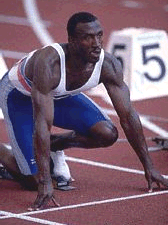 British sprinter Linford Christie, who controversially failed a test for nandrolone earlier this year. |
The drug known as nandrolone (also known commercially as Deca-Durabolin) has the IUPAC name 17b-hydroxy-19-nor-4-andro-sten-3-one, and is an anabolic steroid (a muscle-building chemical) which occurs naturally in the human body, but only in tiny quantities. It is very similar in structure to the male hormone testosterone, and has many of the same effects in terms of increasing muscle mass, without some of the more unwanted side-effects such as increased body hair or aggressive behaviour. As such, it is being actively examined in clinical tests as a possible treatment for wasting diseases, and to strengthen and increase body tissue and musculature in HIV infected men. In this form it is usually injected in its decanoate form, after first being dissolved in a suitable edible oil.
However, what is detected in the drug tests is the metabolism product of this molecule, called 19-norandrosterone, which is excreted from the body in urine, making it easy to obtain samples. A limit of 2 ng per ml of urine (set by the International Olympic Committee) is the maximum concentration thought possible to occur in human body by 'natural means', and if this is exceeded the drug test is considered positive. Since some samples given by athletes have shown levels up to 100 times higher than this, the conclusion is that the athletes must have been taking extra quantities of the drug to enhance their performance.
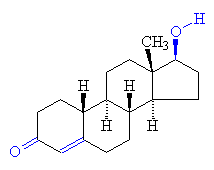
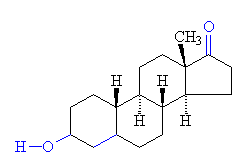
The steroid nandrolone and its metabolite 19-norandrosterone. The structural differences between them consist of a reduction of a double bond to a single bond accompanied by a reduction of a carbonyl to a hydroxyl group in the first ring, and an oxidation of a hydroxyl sidegroup to a carbonyl in the fourth ring. These differences are shown in blue. Click the structures above to access the VRML structure files.
Below for comparison, are the more familiar steroid hormones, testosterone and progesterone. You can see that nandrolone and testosterone are almost identical, differing only by one methyl group, shown in red. Progesterone (the female pregnancy hormone) is also very similar, perhaps giving some credence to the boxer's claim mentioned below...
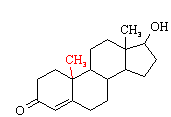
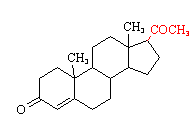
So, if the tests are flawed, what could be going wrong? Many excuses have been put forward to suggest why nandrolone is present in much higher concentrations than it should be. Bobsleigh racer Lenny Paul said that his positive test was due to eating a plate of spaghetti bolognese which contained beef from cattle that had been fed steroids. Although the UK Sport Nandrolone Review Group said that there was only a 'remote' possibility of meat consumption leading to a positive test, the athlete was cleared by his sporting body. Another sportsman, a boxer, said he failed his test after having sex with his pregnant wife! He too, was cleared.
Another possible explanation, often cited by athletes caught with positive tests, is that the nandrolone in their system arose from the use of protein milkshakes and the amino acid creatine, which are perfectly legal and used as dietary supplements to increase weight. But it is difficult to see how nandrolone could be produced from the benign components of these substances, unless they had been accidentally or deliberately contaminated. Subsequent testing, however, ruled out any deliberate contamination.
A much more likely theory has recently emerged from the results of a preliminary investigation at Aberdeen University. The findings are that dietary supplements themselves are harmless and produce no increased levels of nandrolone. Exercise alone, too, doesn't cause any problems. But a combination of both dietary supplements (none of which contain a banned substance) and exercise, can result in a positive nandrolone test. The reason for this is still unclear, but one theory is that there is a link between heavy training, the dehydration that goes with it, and their effects upon the components of high protein diets. Until more work is done, however, the 'nandrolone mystery' goes on...
For a much more detailed review of the issues involved in drug taking and testing in sports, see the excellent article in Chemistry in Britain (vol.36, September 2000) written by Rob Kingston.

